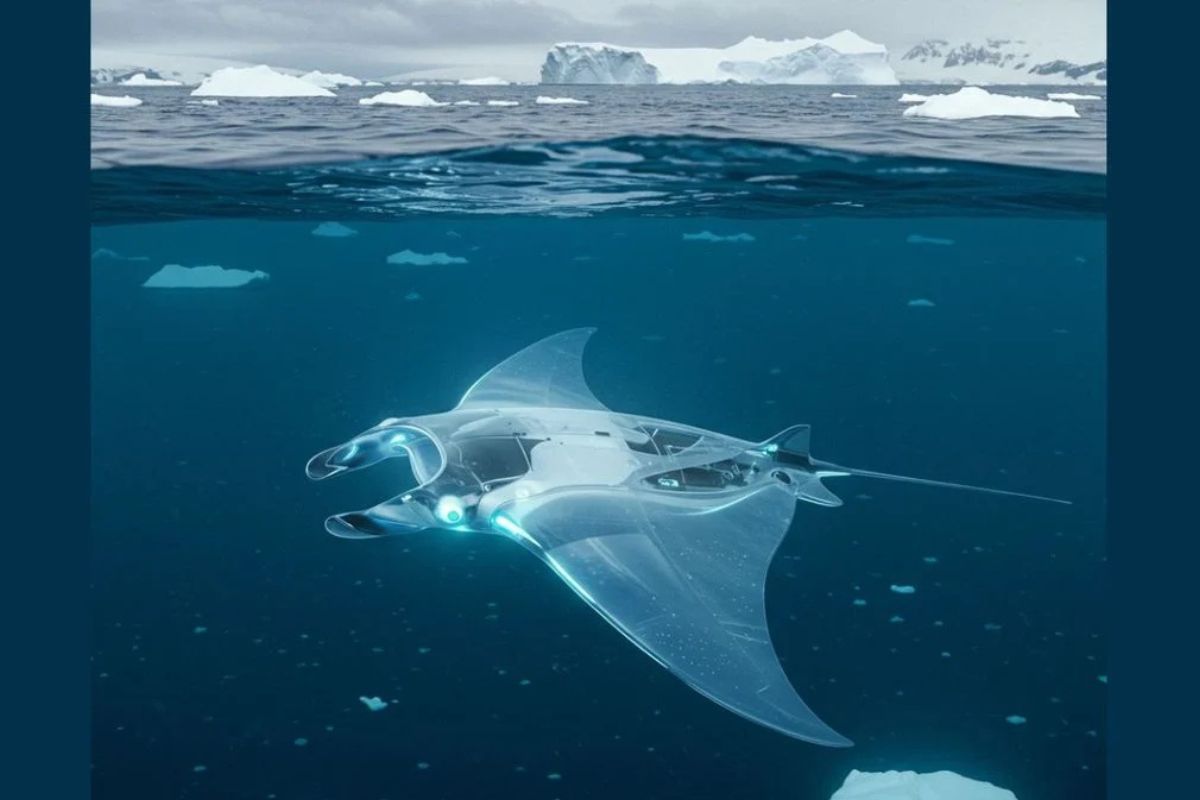Show table of content Hide table of content
The innovative Skiper robot, designed to mimic the Chilean manta ray, represents a groundbreaking advancement in Antarctic marine exploration. This biomimetic marvel combines soft robotics with nature-inspired design to navigate beneath ice sheets without disturbing fragile ecosystems. Developed by a multidisciplinary student team from Adolfo Ibáñez University (UAI) and funded by Corfo’s Inicia Sostenible program, this underwater explorer aims to reveal mysteries hidden beneath Antarctica’s icy waters – a region crucial for understanding climate change yet largely unexplored due to extreme conditions and accessibility challenges.
Biomimetic innovation: how Skiper emulates nature for scientific discovery
Skiper’s design draws inspiration from the Mobula tarapacana, commonly known as the Chilean manta ray. This elegant marine creature’s efficient gliding movements have been translated into a technological marvel through soft robotics principles. Unlike conventional rigid underwater vehicles that can disturb marine environments, Skiper embraces flexibility and fluid motion to blend seamlessly with aquatic surroundings.
“The biomimetic design allows for more natural integration of the device within the environment,” explains Benjamin Loubies, one of the talented student engineers behind the project. This natural integration is crucial when operating in sensitive ecosystems like those found in Antarctica, where invasive species and environmental disruptions can have devastating consequences on delicate ecological balances.
Soft robotics technology allows Skiper to navigate through challenging underwater terrain with minimal disturbance. Its silicone-based components and specialized circuits create movements that closely resemble those of its biological inspiration. This fluid locomotion enables the robot to access areas that would be otherwise impossible to reach with traditional exploration equipment.
The development team, comprised of mechanical engineering, bioengineering, and design students, has been granted 15 million pesos (approximately $16,000 USD) to refine their prototype over a one-year period. During this time, they’ll conduct simulated environment testing and present their innovation at scientific exhibitions, gradually preparing Skiper for its ultimate mission beneath Antarctic ice.
Antarctic underwater exploration: revealing hidden secrets beneath the ice
Antarctica serves as one of the world’s most significant natural laboratories, yet paradoxically remains among the least accessible. The extreme conditions that characterize this southernmost continent present formidable challenges for scientific research. Traditional exploration technologies often pose threats to its delicate ecological balance rather than facilitating beneficial study.
Nicomedes Pommier, another key developer on the project, highlights that “thanks to its flexible, non-invasive design, this robot collects essential data in extreme environments without disturbing the ecosystem.” This non-disruptive approach represents a crucial advancement in polar research methodology, where conservation concerns must balance with scientific discovery.
Science This strange red lake in Tanzania turns animals to ‘stone’.
Skiper’s revolutionary design will enable the deployment of various sensors, reaching remote underwater areas and safely collecting data that has previously remained inaccessible. The robot’s capabilities could transform our understanding of sub-ice environments, similar to how unexpected discoveries in marine environments continue to shape our understanding of ocean ecosystems worldwide.
Natalia Wensioe, who led initial research for the project, explained in an interview with La Tercera: “Antarctica is a thermometer for climate change, but exploring its underwater ecosystem remains a significant challenge.” Skiper aims to bridge this knowledge gap by providing unprecedented access to these mysterious waters while maintaining environmental integrity.
The future impact of manta-inspired underwater robotics
The UAI student team has clearly identified the problem they’re addressing, stating that “given the enormous percentage we don’t know about this underwater environment, it’s essential to provide adequate protection for species and anticipate consequences caused by climate change.” Their dedication to environmental preservation echoes the commitment of other pioneers using technology for conservation, much like award-winning conservation initiatives that combine innovation with environmental protection.
The implications of Skiper’s development extend far beyond Antarctica. The principles behind this soft robotic manta ray could revolutionize marine exploration globally, offering a template for non-invasive underwater research in fragile ecosystems worldwide. The technology demonstrates how biomimicry can solve complex engineering challenges while respecting natural environments.
With financial backing from Corfo’s Inicia Sostenible fund, the interdisciplinary team has created a prototype that embodies respect, innovation, and sustainability. While Skiper hasn’t yet navigated Antarctic waters, it represents a promising approach to scientific exploration that works with nature rather than against it.
The project timeline gives the team one year to perfect their prototype through rigorous testing in simulated environments before potential deployment. As climate change continues to impact polar regions, technologies like Skiper become increasingly vital for understanding these vulnerable ecosystems before they undergo irreversible changes.
Between cables, prototypes, and simulated icy water tests, Skiper steadily progresses toward its mission. Though its fins are made of silicon and circuits rather than flesh and blood, it carries something as alive as the sea it seeks to explore: the hope for science that supports rather than disrupts the natural world. This biomimetic marvel stands as testimony to how young scientists can create sustainable solutions to complex global challenges.


